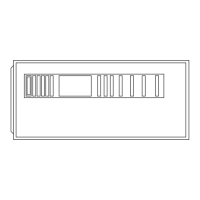controls into containers before touching ungrounded objects.
7. An ESD service kit (available from commercial sources) may
also be used to prevent ESD damage.
PROPERTY DAMAGE
Failure to follow this caution may result in minor property
damage.
Local codes may require a drain pan under entire furnace and
condensate trap when a condensing furnace is used in an attic
application or over a finished ceiling.
APPLICATIONS
Step 1—General
Some assembly and modifications are required for furnaces
installed in any of the 4 applications shown in Fig. 1. All drain and
pressure tubes are connected as shown in Fig. 6. See appropriate
application instructions for these procedures.
Step 2—Upflow Applications
An upflow furnace application is where furnace blower is located
below combustion and controls section of furnace, and conditioned
air is discharged upwards.
CONDENSATE TRAP LOCATION (FACTORY-SHIPPED
ORIENTATION)
The condensate trap is factory installed in the blower shelf and
factory connected for UPFLOW applications. A factory-supplied
tube is used to extend the condensate trap drain connection to the
desired furnace side for field drain attachment. See Condensate
Trap Tubing (Factory-Shipped Orientation) section for drain tube
extension details. (See Fig. 5.)
CONDENSATE TRAP TUBING (FACTORY-SHIPPED
ORIENTATION)
NOTE: See Fig. 6 or tube routing label on main furnace door to
confirm location of these tubes.
1. Collector Box Drain, Inducer Housing Drain, Relief Port, and
Pressure Switch Tubes.
These tubes should be factory attached to condensate trap and
pressure switch ready for use in UPFLOW applications. These
tubes can be identified by their connection location and also
by a color label on each tube. These tubes are identified as
follows: collector box drain tube (blue label), inducer housing
drain tube (violet label or molded), relief port tube (green
label), and pressure switch tube (pink label).
2. Condensate Trap Drain Tube
The condensate trap drain connection must be extended for
field attachment by doing the following:
a. Determine location of field drain connection. (See Fig. 2 or
6.)
NOTE: If internal filter or side Filter/Media Cabinet is used, drain
tube should be located to opposite side of casing from return duct
attachment to assist in filter removal.
b. Remove and discard casing drain hole plug button from
desired side.
c. Install drain tube coupling grommet (factory-supplied in
loose parts bag) in selected casing hole.
d. Slide drain tube coupling (factory-supplied in loose parts
bag) through grommet ensuring long end of coupling faces
blower.
e. Cement 2 factory-supplied 1/2-in. street CPVC elbows to
the rigid drain tube connection on the condensate trap. (See
Fig. 6.) These elbows must be cemented together and
cemented to condensate trap drain connection.
NOTE: Failure to use CPVC elbows may allow drain to kink and
prevent draining.
f. Connect larger diameter drain tube and clamp (factory-
supplied in loose parts bag) to condensate trap and clamp
securely.
g. Route tube to coupling and cut to appropriate length.
h. Attach tube to coupling and clamp securely.
CONDENSATE TRAP LOCATION (ALTERNATE UPFLOW
ORIENTATION)
An alternate location for the condensate trap is the left-hand side
of casing. (See Fig. 2 and 7.)
NOTE: If the alternate left-hand side of casing location is used,
the factory-connected drain and relief port tubes must be discon-
nected and modified for attachment. See Condensate Trap Tubing
(Alternate Upflow Orientation) section for tubing attachment.
To relocate condensate trap to the left-hand side, perform the
following:
1. Remove 3 tubes connected to condensate trap.
2. Remove trap from blower shelf by gently pushing tabs inward
and rotating trap.
3. Install casing hole filler cap (factory-supplied in loose parts
bag) into blower shelf hole where trap was removed.
CARBON MONOXIDE POISONING HAZARD
Failure to follow this warning could result in personal injury
or death.
Casing hole filler cap must be installed in blower shelf hole
when condensate trap is relocated.
4. Install condensate trap into left-hand side casing hole by
inserting tube connection stubs through casing hole and
rotating until tabs snap into locking position.
5. Fill unused condensate trap casing holes with plastic filler
caps (factory-supplied in loose parts bag).
CONDENSATE TRAP TUBING (ALTERNATE UPFLOW
ORIENTATION)
NOTE: See Fig. 7 or tube routing label on main furnace door to
confirm location of these tubes.
Fig. 4—Return-Air Temperature
A93042
6
→

